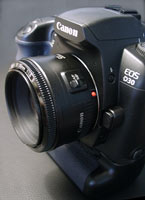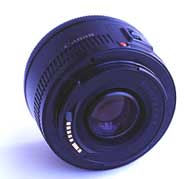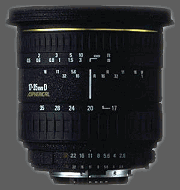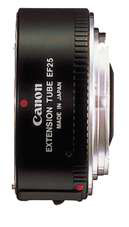My Canon D30 and accessories
Casio QV2000UX was the camera, which converted me to Digital format.
I shoot thundreds of photographs and still own that wonderful piece of
equipment. Being a 2.1 Mega pixel consumer level camera, it has its limitations.
The biggest one, which plagued me every day, was the inability to focus
manually in broad day light as tiny LCD at back washed out completely
in sun light.
I out grew the Casio soon and switched over to Canon D30.
My Lens collection
I am a prime lens lover. No Zoom lens, however costly it may be can not
able to provide the same optical quality of a prime lens. The down sides
are then you have to spend more money in buying a collection of Pime lenses
and lug them around with you. You need to change them to alter focal length.
This can be tricky and risky when wind is blowing, or when there are suspended
particles in air. However, the images are so gratifying that I am willing
to take all those trouble :-)
I first bought two Lenses even before buying my D30 Camera body. They
are Canon 50mm f1.8 II and Sigma 17-35mm APO.
Canon 50mm f1.8 II
I am all praise about this lens. For 80$, it is the very best value for
money Canon offers to us. I never seized to be thrilled by its sharpness
even at wide open f1.8 and excellent color rendition. Many photographers
do not even consider buying a 50mm standard lens, but they do not know
what they are missing! This cheap piece of glass produces such an excellent
image, which is unattainable even with many 1000$ L series lens. To be
honest I can not see any difference in optical quality when I compared
it with 50mm f/1.4 version, apart from the fact 50mm f1.4 produces better
bokeh at full aperture.
This is an indispensable lens for me in low available light photography.
Moreover on D30, it provides a focal length equivalent of 80mm on 35mm
camera. So it becomes the best portrait lens also.

The only downside of this lens is its cheap construction. It is made of
plastic. Even the lens mount is made of plastic. There is no distance
marking on the focussing ring and the lens does not have a USM. So auto
focus is noisy and slow. You may mistake it as a piece of junk, till you
see its photograph. I love this lens and never go outside without it.
To me this is the most dependable lens which never failed to provide best
picture quality.
Sigma 17-35mm F/2.8-4.0
The 1.6 multiplier of D30 is a boon for Telephoto lover, but it makes real tricky to get a wide-angle lens for it. The conventional 28mm wide-angle for 35mm camera becomes 28X1.6= 44.6mm normal lens for D30! So you need to use an ultra wide-angle for 35mm format to achieve a moderately wide-angle on D30. There is not much choice, only a handful of ultra wide zooms are available for Canon. The 17-35by Canon is way too expensive and not so great in optical quality. Sigma is almost one-third the price of a Canon and a bit inferior in optical quality, noisy auto focus and very loose focussing ring. My pocket primarily governed the purchase decision of this lens. It is by no means a great lens and shows a great deal of purple fringing, but I can not complain much with its 450$ price tag. The Canon one would have cost me more than 1200$
Canon 300mm f4L
I bought Canon 300/f4L after doing considerable research and soul searching!
L glasses are not cheap, and my requirements were many. I needed a medium
telephoto for portraits, a medium to long Zoom and a really long Telephoto
for wild life photography. Unfortunately my budget was limited and lens
price were not. So I decided to buy the long telephoto first and keep
the other two lenses in my wish list. In the long telephoto range, Canon
300mm f4 L looked most attractive to me. The two reasons for selecting
this lens are as follows
1) It is one of the sharpest and finest Telephoto Lens Canon manufactures.
2) It is the longest non IS (Image Stabilized) lens, possible to handhold
shoot in bright day light.
I spend few days in test shooting it to get accustomed to the feel of
the long heavy off-white lens. One prime lesson I have learnt was the
rule of thumb for computing minimum handheld shutter speed is different
for D30. Click the link for more details.
Canon 300mm f4L is indeed a magnificent lens. My money was well spent.
Images are tack sharp up to the fullest aperture provided I can keep it
stable enough. It forced me to invest on a monopod also. But again, a
monopod and tripod are perhaps the most essential accessories you can
purchase for any long telephoto lens.
MonoPod
Ihave tested several monopods. Basically I was looking for a sturdy support
for my Canon 300 fitted with D30 and BG-ED3 Battery Grip. The total weight
was quite heavy (4 Kilogram or 9 lb approximately). The small cute looking
monopods are no good. They simply bowed with the weight. The bigger ones
are two cumbersome to open and close. Few of them are too costly for my
budget.
Ultimately I have settled for Velbon UP-4DXII. It is quite cheap, only
40$ (at Frys). It comes along with a shoulder strap and a quick release
plate. The Monopod is small enough to tie with the inbuilt harness on
my Camera Bag, so that I do not have to carry is separately.
I bought an extra Velbon quick release plate. I keep them always fitted
on my 300 mm and on the BG-ED3 grip. Whenever possible, I use the monopod
while shooting with 300mm. It allows me to use shutter speed as low as
1/100.
Timer Remote TC-80N3
 Timer
Remote TC-80N3 I had ordered along with my D30. Though not a frequently
used accessory, but it comes handy during tripod shooting. The main difference
of Timer Remote with normal remote RS-80N3 is, you can program all the
variables like self timer delay, number of shots, time exposure duration
of each shots and interval between shots. So it can be used as an extra
long duration self timer, time lapse photo timer, time exposure controller
as well as a electronic cable release. I use it while shooting panoramic
pictures also. Timer
Remote TC-80N3 I had ordered along with my D30. Though not a frequently
used accessory, but it comes handy during tripod shooting. The main difference
of Timer Remote with normal remote RS-80N3 is, you can program all the
variables like self timer delay, number of shots, time exposure duration
of each shots and interval between shots. So it can be used as an extra
long duration self timer, time lapse photo timer, time exposure controller
as well as a electronic cable release. I use it while shooting panoramic
pictures also.
Extension Tube EF25
 I needed
a macro lens. I had selected Canon 100mm f2.8 Macro USM, a tack sharp
macro lens that also performs equally well as a medium telephoto. But
buying all Canon gadgets in a single go left me with no extra funds. So
I decided to buy an extension tube EF25. I paid 60$ and bought it pre
owned from a Internet mail order company. It couples between the lens
and camera body, and provides macro-focussing capability to many lenses.
I primarily use it with my normal lens Canon 50mm f1.8. It also works
with Canon 300mm and reduces its near focussing distance from 2 meter
to about 4 feet. EF25 provides full camera lens and body electrical contacts
so you do not lose the auto focus or aperture control by the camera. As
there is no lens elements in the extension tube, it does not affect the
image sharpness at all. It allows me to get very sharp macro
photographs with my 50mmf1.8 normal lens. I needed
a macro lens. I had selected Canon 100mm f2.8 Macro USM, a tack sharp
macro lens that also performs equally well as a medium telephoto. But
buying all Canon gadgets in a single go left me with no extra funds. So
I decided to buy an extension tube EF25. I paid 60$ and bought it pre
owned from a Internet mail order company. It couples between the lens
and camera body, and provides macro-focussing capability to many lenses.
I primarily use it with my normal lens Canon 50mm f1.8. It also works
with Canon 300mm and reduces its near focussing distance from 2 meter
to about 4 feet. EF25 provides full camera lens and body electrical contacts
so you do not lose the auto focus or aperture control by the camera. As
there is no lens elements in the extension tube, it does not affect the
image sharpness at all. It allows me to get very sharp macro
photographs with my 50mmf1.8 normal lens.
This site is under construction
|